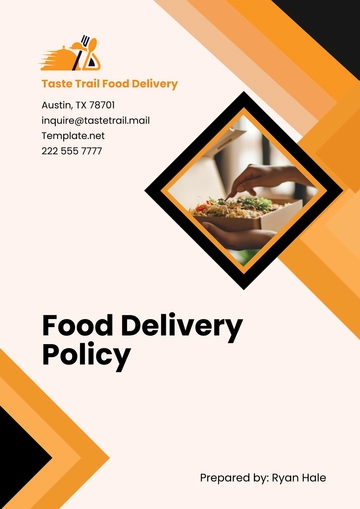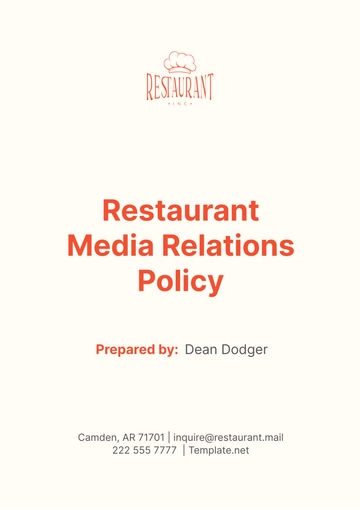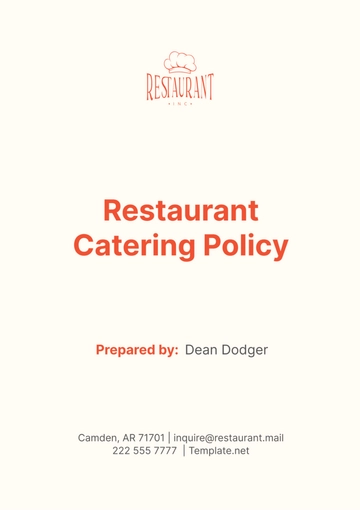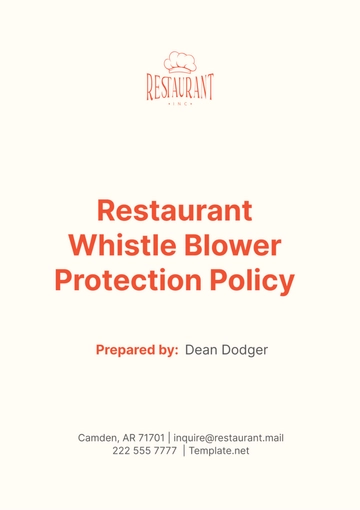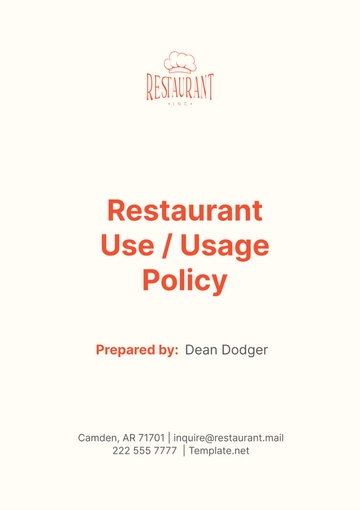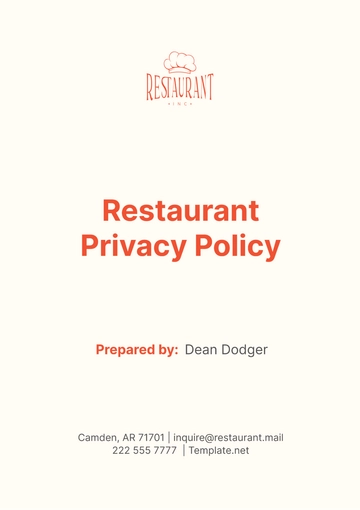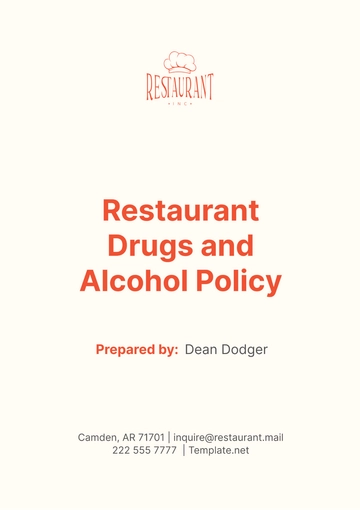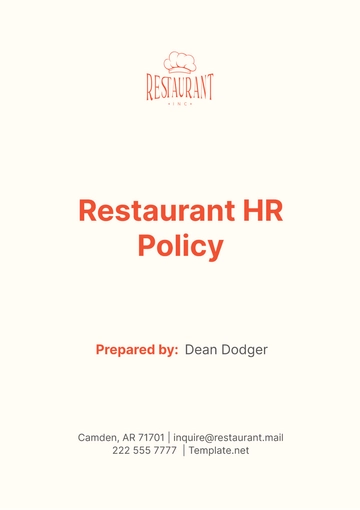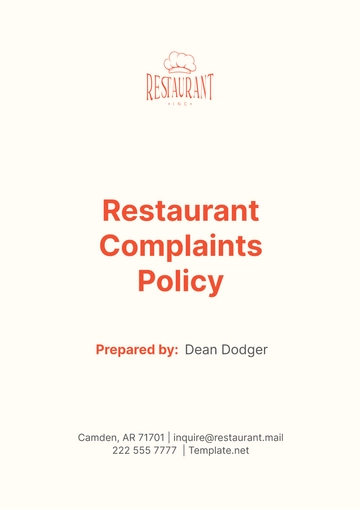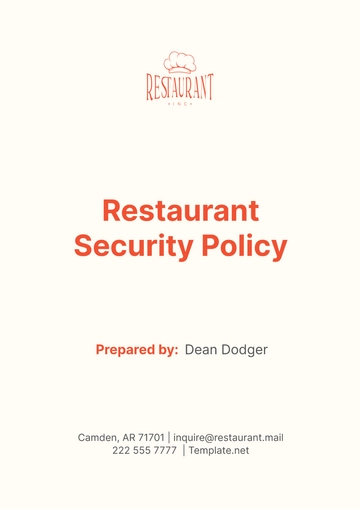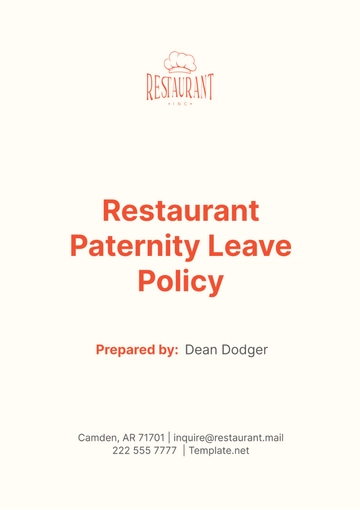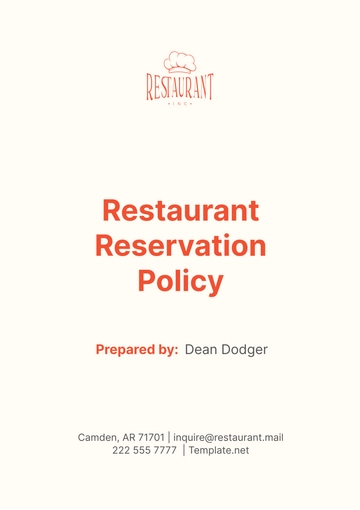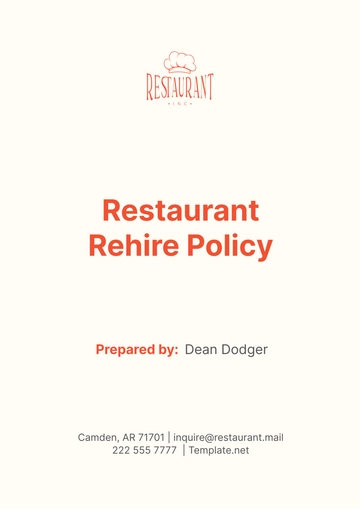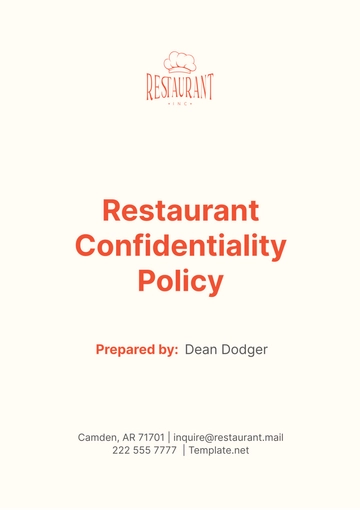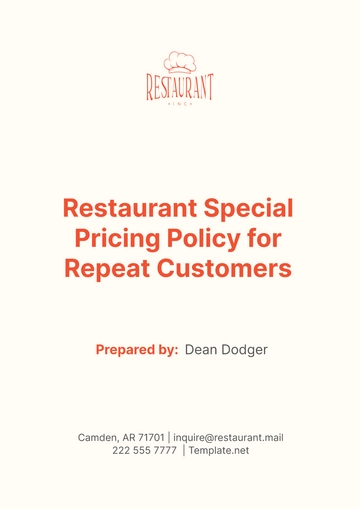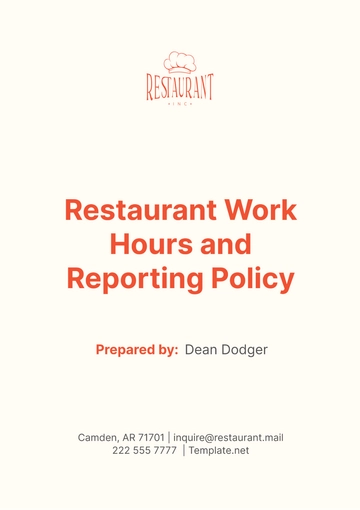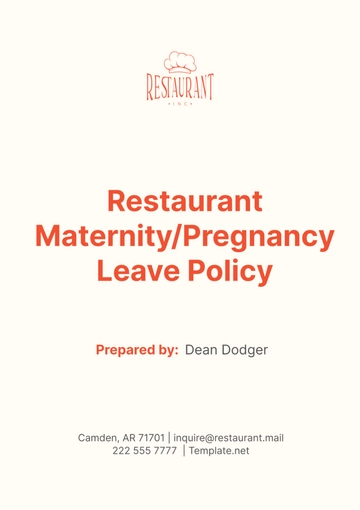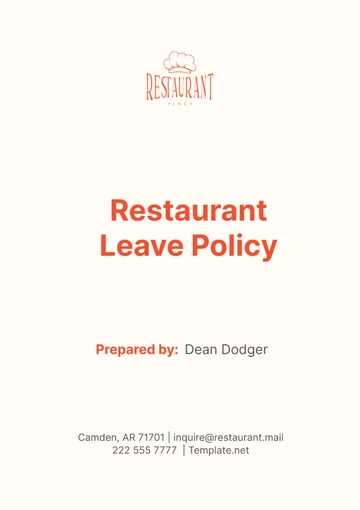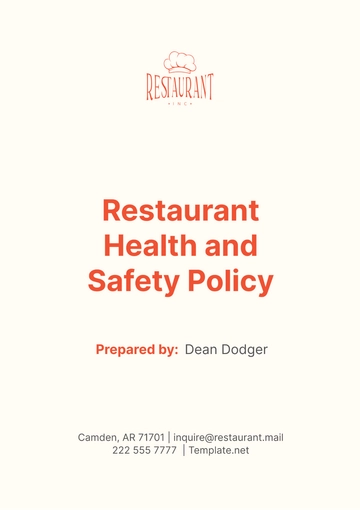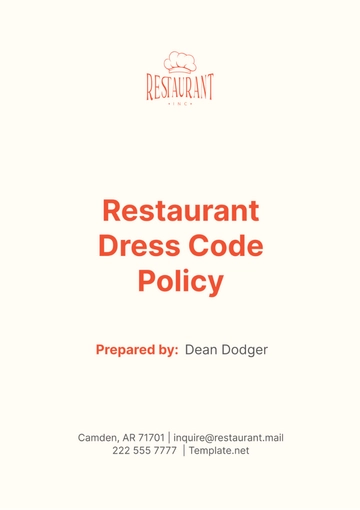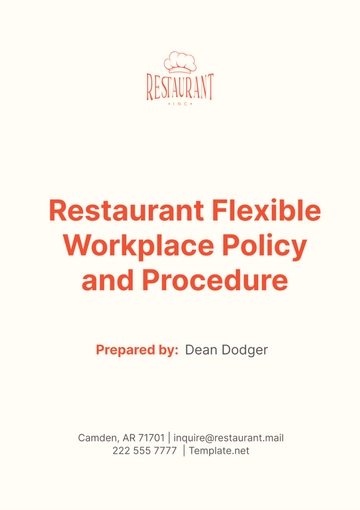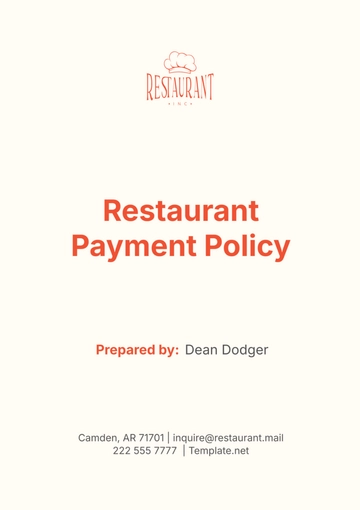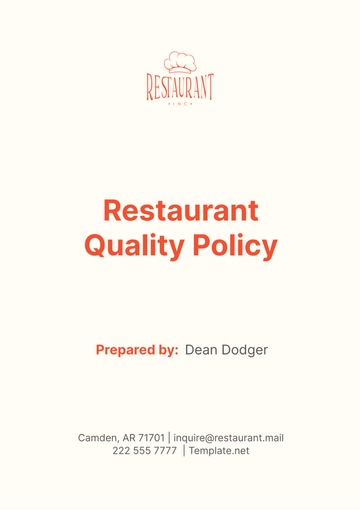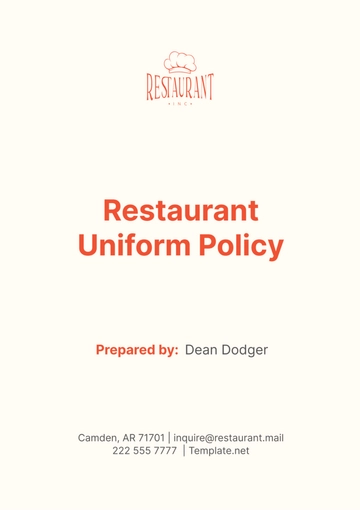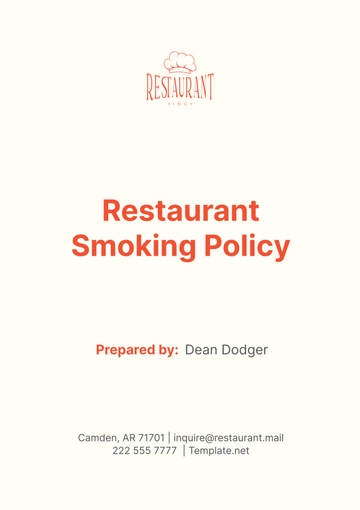Free Restaurant Food Safety Policy
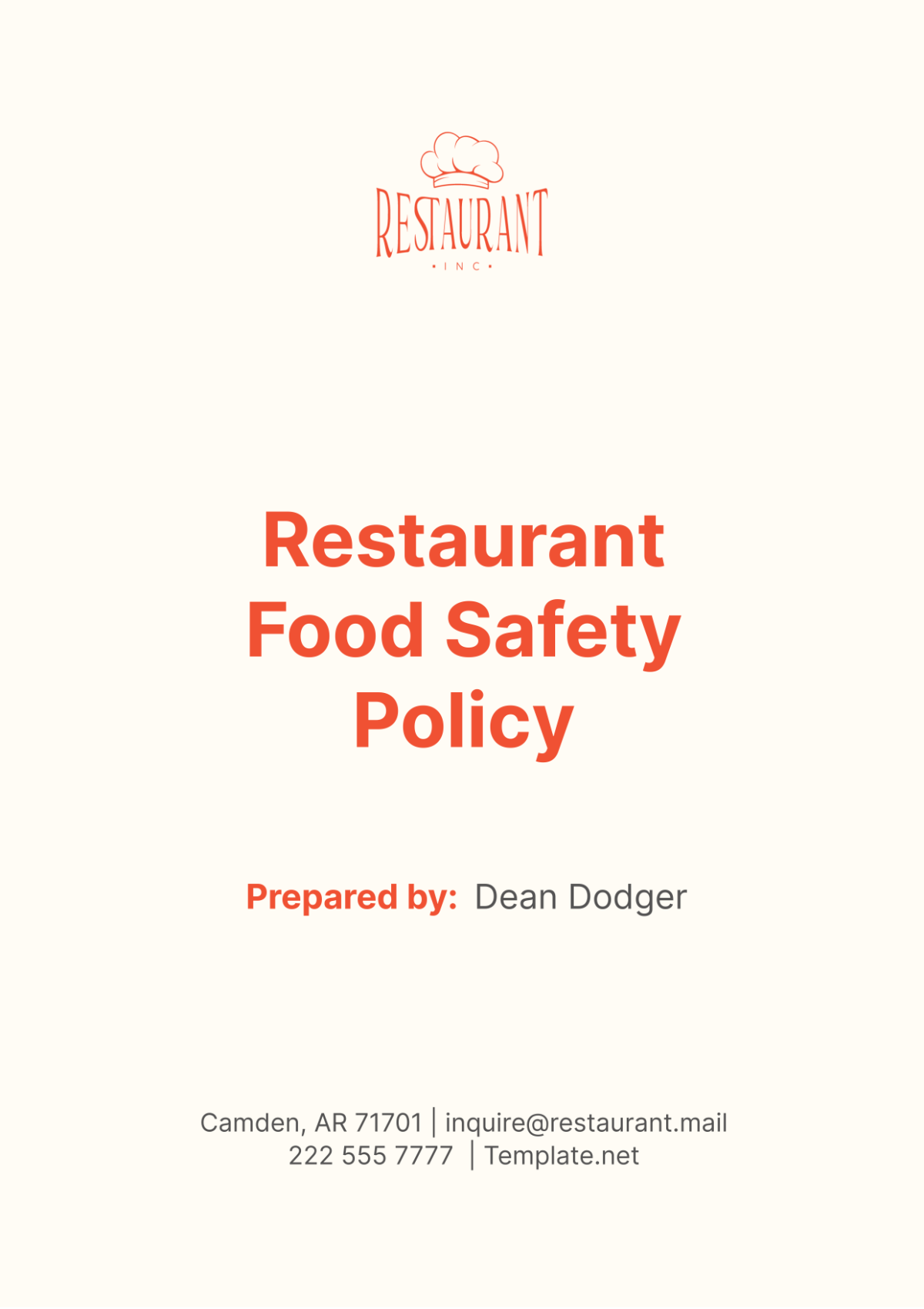
I. Policy Overview
This policy outlines our commitment to ensuring the safety and well-being of our customers through rigorous food safety practices. It applies to all aspects of food handling, from sourcing to serving, and emphasizes compliance with health regulations and the promotion of a strong food safety culture among our staff.
A. Purpose
The purpose of [Your Company Name]'s Food Safety Policy is to prioritize the safety and well-being of our customers by maintaining the highest standards of food safety and hygiene. We aim to comply with all relevant health regulations and foster a culture of food safety among our staff.
B. Scope
This policy applies to all employees, contractors, and stakeholders involved in the preparation, handling, and service of food in our restaurant. It covers all aspects of food safety, including sourcing, storage, preparation, cooking, and serving of food.
C. Policy Statement
Food Sourcing: We will source our ingredients from reputable suppliers to ensure their quality and safety. All deliveries will be inspected upon arrival to verify freshness and proper packaging.
Storage: Proper storage practices will be followed to prevent cross-contamination and spoilage. Perishable items will be stored at the correct temperatures, and all food will be properly labeled and dated.
Preparation: Food will be prepared in a clean and sanitized environment, following strict hygiene practices. Employees will wash their hands regularly and wear appropriate protective clothing.
Cooking: All food will be cooked thoroughly to the correct temperatures to ensure that harmful bacteria are eliminated. Temperature logs will be maintained for monitoring.
Serving: Food will be served using clean utensils and surfaces to prevent contamination. Buffet areas will be monitored and replenished frequently to maintain food safety standards.
Cleaning and Sanitizing: Regular cleaning and sanitizing of all food contact surfaces, utensils, and equipment will be conducted to prevent the growth of harmful bacteria.
Training and Education: All employees will receive comprehensive training on food safety practices and procedures. Regular refresher courses will be provided to ensure that staff remain updated on the latest protocols.
Compliance and Audits: Regular audits and inspections will be conducted to ensure compliance with this policy and relevant health regulations. Any non-compliance will be addressed promptly.
Communication: This policy will be communicated to all employees, contractors, and stakeholders involved in food handling. Any updates or changes to the policy will be communicated promptly.
II. Responsibilities
Establishing clear responsibilities is essential for ensuring the effective implementation of our Food Safety Policy at [Your Company Name]. The following outlines the responsibilities of both management and employees in upholding our commitment to food safety.
A. Management Responsibilities
Setting the Tone: Management is responsible for setting the tone for a culture of food safety within the organization. This includes demonstrating and promoting safe food handling practices.
Training and Equipping Staff: Management must ensure that all staff are adequately trained and equipped to follow the food safety guidelines outlined in this policy.
Conducting Audits and Inspections: Regular audits and inspections will be conducted by management to ensure compliance with this policy and to identify areas for improvement.
B. Employee Responsibilities
Adhering to Guidelines: All employees must adhere to the food safety guidelines and procedures outlined in this policy. This includes following proper handwashing techniques and wearing appropriate protective clothing.
Participating in Training: Employees are required to participate in regular food safety training to ensure they are up-to-date with the latest protocols.
Reporting Incidents: Employees must report any incidents or breaches of food safety protocols to their supervisors immediately to prevent foodborne illnesses and ensure the safety of our customers.
III. Food Safety Procedures
Ensuring the safety of our food is a top priority at [Your Company Name]. These procedures are designed to maintain the highest standards of food safety and hygiene throughout our operations.
A. Food Sourcing
Approved Suppliers: All food ingredients must be sourced from approved suppliers who comply with safety and hygiene standards. This includes verifying that suppliers have proper certifications and documentation.
Regular Audits: Regular audits of suppliers will be conducted to ensure compliance with our standards. Any suppliers found to be non-compliant will be addressed promptly.
B. Storage
Appropriate Temperatures: All food items must be stored at appropriate temperatures to prevent contamination and spoilage. This includes refrigerating perishable items and storing dry goods in a cool, dry place.
Proper Labeling: Proper labeling of all food items is essential to ensure the freshness and safety of the food. Labels should include the date of receipt and the expiration date.
Rotation of Stock: Proper rotation of stock is necessary to ensure that older items are used before newer ones. This helps prevent food waste and ensures that food is always fresh.
Storage Methods for Food Types:
Food Type | Storage Method |
|---|---|
Perishable | Refrigerate at 40°F (4°C) or below |
Dry Goods | Store in a cool, dry place |
Frozen Foods | Keep frozen at 0°F (-18°C) or below |
C. Preparation
Clean and Sanitized Areas: Food preparation areas must be kept clean and sanitized at all times to prevent cross-contamination. This includes regular cleaning of surfaces and equipment.
Separation of Foods: To avoid cross-contamination, separate equipment and utensils must be used for raw and cooked foods. This includes using different cutting boards and utensils.
Personal Hygiene: Staff must maintain strict personal hygiene, including regular handwashing and wearing clean clothing and hairnets.
Preparation Methods for Food Types:
Food Type | Preparation Method |
|---|---|
Meat | Cook to recommended internal temperature |
Vegetables | Wash thoroughly before cooking |
Dairy Products | Keep refrigerated at all times |
D. Cooking
Recommended Internal Temperatures: All foods must be cooked to their recommended internal temperatures to ensure that pathogens are destroyed. This includes using a food thermometer to check the temperature.
Equipment Maintenance: Cooking equipment must be regularly cleaned and maintained to prevent contamination. This includes cleaning grills, ovens, and fryers after each use.
E. Serving
Safe Temperatures: Food must be served at safe temperatures to prevent foodborne illnesses. Hot foods should be kept hot, and cold foods should be kept cold.
Appropriate Utensils: Food should be served with appropriate utensils to avoid contamination. Utensils should be properly sanitized between uses to prevent the spread of germs.
Clean Service Areas: Staff must ensure that service areas are clean and free from contamination. This includes regularly cleaning and sanitizing surfaces and utensils.
IV. Monitoring and Compliance
Monitoring and ensuring compliance with our Food Safety Policy is essential for maintaining the highest standards of food safety at [Your Company Name].
Regular Audits: Regular internal and external audits will be conducted to ensure compliance with this policy. These audits will assess adherence to food safety procedures and identify areas for improvement.
Violation Response: Any violations identified during audits will be addressed promptly. Corrective actions will be taken to prevent recurrence and improve overall compliance.
Policy Review: Management will review and update this policy annually or as necessary to remain compliant with new regulations and to improve food safety standards.
V. Reporting
Open communication is key to maintaining a safe and healthy environment. Employees are encouraged to report any food safety concerns or violations to their supervisors immediately.
Encouraged Reporting: Employees are encouraged to report any food safety concerns or violations to their supervisors immediately. This includes issues related to food handling, storage, and sanitation.
Anonymous Reporting: Anonymous reporting mechanisms will be provided to ensure that all concerns are addressed without fear of retribution. This allows employees to report issues openly and honestly, leading to a safer work environment.
VI. Contact Information
If you have any questions or need further information about this policy, please contact us:
Email Address: | [Your Company Email] |
|---|---|
Phone Number: | [Your Company Number] |
By following this policy, we believe we can enhance our restaurant's unique identity while ensuring the safety and satisfaction of our valued customers.
- 100% Customizable, free editor
- Access 1 Million+ Templates, photo’s & graphics
- Download or share as a template
- Click and replace photos, graphics, text, backgrounds
- Resize, crop, AI write & more
- Access advanced editor
Prioritize food safety with the Restaurant Food Safety Policy Template, exclusively on Template.net. This template offers a framework for establishing and implementing food safety policies in your restaurant. With editing capabilities in our Ai Editor Tool, create a policy that ensures compliance and protects the health of your customers.
You may also like
- HR Policy
- Restaurant Policy
- Company Policy
- Accounting Policies and Procedures
- Website Policy
- Privacy Policy
- Safety Policy
- School Policy
- IT and Software Policy
- Law Firm Policy
- Construction Policy
- Interior Design Policy
- Travel Agency Policy
- Education Academic Policy
- Security Policy
- Real Estate Policy
- Expense Policy
- Software Policy
